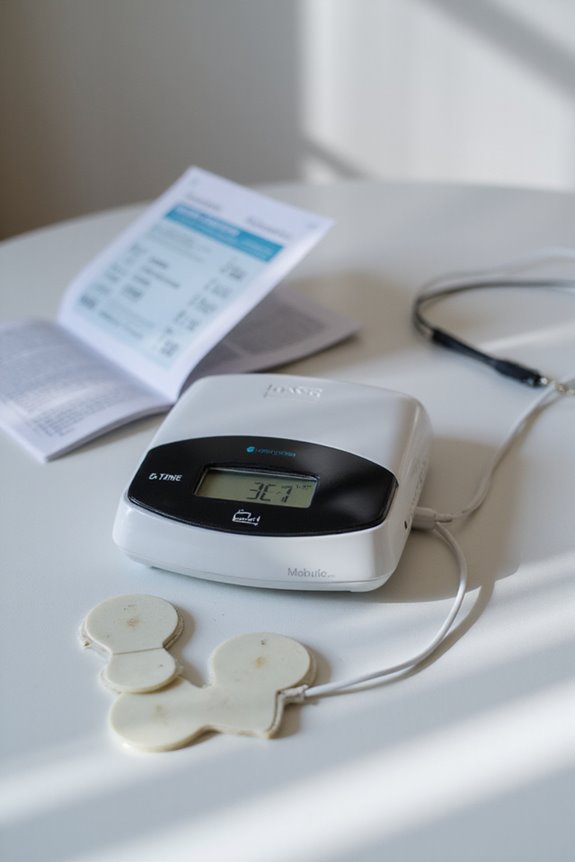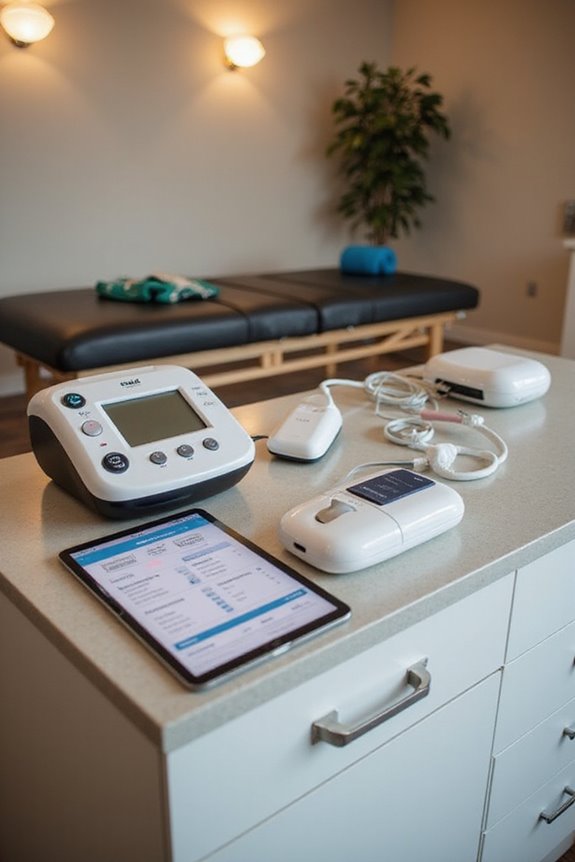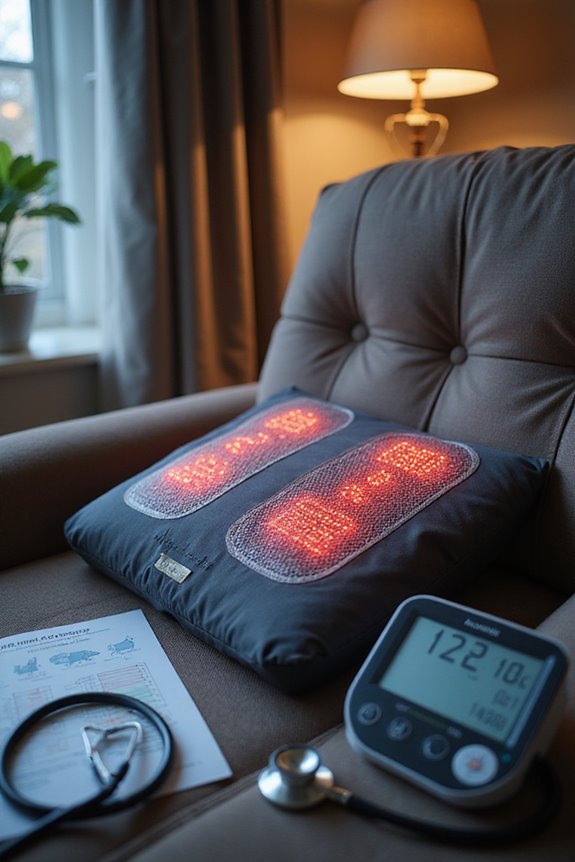TENS units should be used based on pain type. For acute pain relief, sessions of 20–60 minutes are advisable, multiple times daily. For chronic pain, recommended usage is 20–30 minutes, ideally daily. Higher frequencies (80–120 Hz) suit acute conditions, while lower frequencies (2–10 Hz) benefit chronic pain. Breaks of at least 10 minutes between sessions are necessary to prevent skin irritation. Further insights on usage techniques and safety precautions are available for better outcomes.
Key Takeaways
- For acute pain relief, use the TENS unit for 20-60 minutes, up to 1-4 times daily based on comfort.
- Chronic pain management typically involves 20-30 minute sessions, with daily use recommended for optimal results.
- Adjust pulse frequency to 80-120 Hz for acute pain and 2-10 Hz for chronic pain relief.
- Ensure a minimum of 10 minutes break between sessions to prevent skin irritation and promote muscle recovery.
- Regular usage can lead to long-term pain relief and reduced reliance on medications, enhancing overall quality of life.
Understanding TENS Units and Their Purpose
TENS units, or Transcutaneous Electrical Nerve Stimulation devices, serve a pivotal role in pain management. These portable devices deliver mild electrical stimulation to activate the body’s pain relief mechanisms, including the Pain Gate Mechanism and the Endogenous Opioid System.
TENS Unit Benefits:
- Pain management: Effective for various conditions, such as arthritis and postoperative pain.
- Adjustable settings: Users can control pulse width, frequency, and intensity for comfort.
- Types of currents: High-frequency (80-120 Hz) for acute pain and low-frequency (1-20 Hz) for chronic pain.
Many TENS units have FDA approval, ensuring safety and effectiveness. However, it is recommended to consult a healthcare provider for ideal use and to determine suitable applications for individual needs.
Recommended Duration for Acute Pain Relief
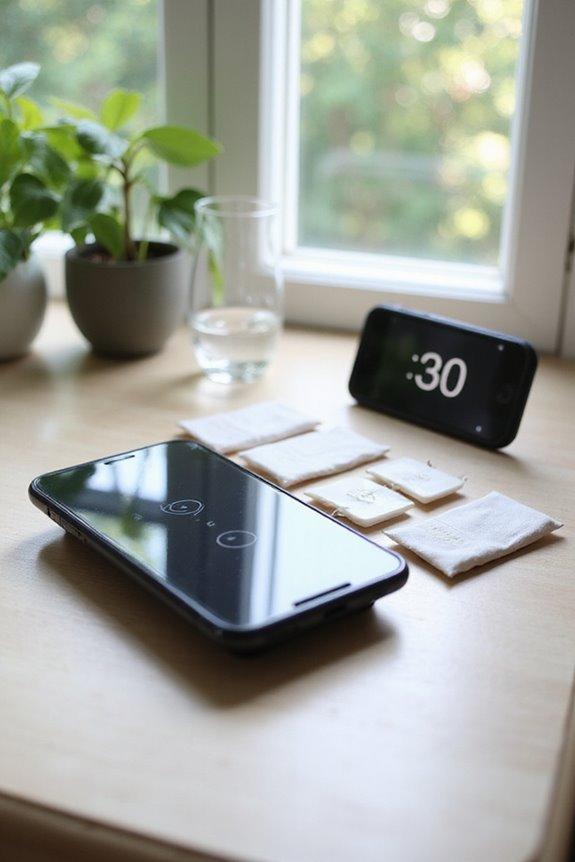
When managing acute pain, the recommended duration for TENS unit sessions is essential for effectiveness.
- Initial sessions: Less than 20 minutes are often advised.
- Alternative recommendations: Sessions lasting 20–60 minutes can be utilized multiple times a day.
- Typical frequency: Patients may engage in 1–4 sessions daily, depending on comfort and symptom response.
- Customization: Session duration should be adjusted based on individual tolerance and relief obtained.
- Guidelines: Higher frequencies (80–120 Hz) and shorter pulse widths (175–200 microseconds) are ideal for acute pain.
Patients are encouraged to monitor for skin irritation and adjust usage accordingly. Overall, short, frequent sessions are generally preferred for effective pain management in acute situations.
Suggested Usage for Chronic Pain Management
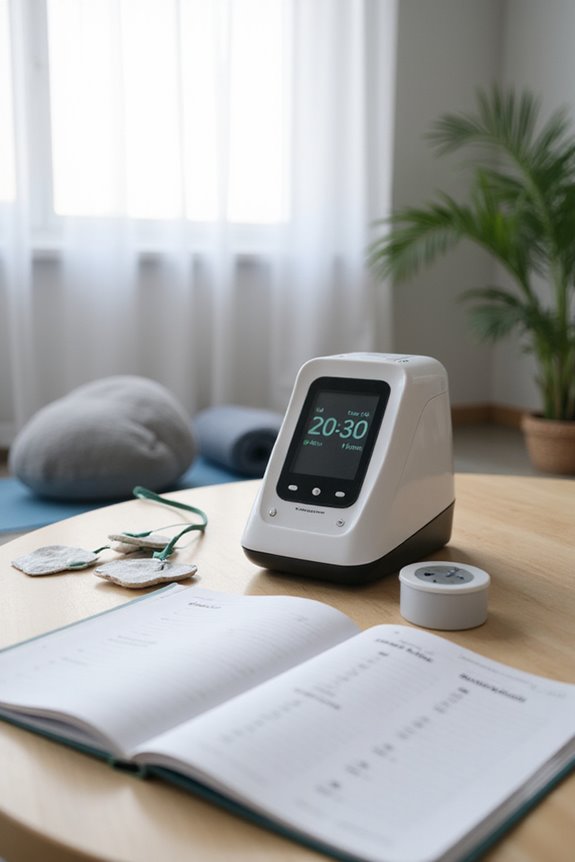
Chronic pain management often benefits from the regular use of a TENS unit, with suggested protocols emphasizing specific session lengths and frequencies.
- Typical session length: 20–30 minutes per session is commonly recommended.
- Usage frequency: Most guidelines suggest daily use for best results, with some protocols allowing up to five sessions weekly.
- TENS settings: Effective pain relief often occurs at a pulse frequency of 2–10 Hz.
- Customization: Settings should be tailored according to pain location and severity.
For many individuals, consistent use can lead to improved outcomes, although professional guidance is advisable, especially if users consider exceeding recommended frequencies. Overall, establishing a personalized regimen can greatly enhance chronic pain management effectiveness.
Importance of Breaks Between Sessions

Effective pain management protocols, particularly those involving TENS units, recognize the significance of incorporating breaks between sessions.
Preventing Skin Irritation
- Electrode Removal: Extended use may lead to skin irritation. Breaks allow the skin to recover from adhesive pressure.
- Skin Checks: Inspect for redness post-session to verify user comfort.
Optimizing Comfort and Tolerance
- Break Duration: Users should take regular pauses to prevent overstimulation.
- Gradual Increase: Start with shorter sessions, increasing duration as tolerance builds.
Avoiding Muscle Fatigue
- Recovery Periods: Breaks facilitate muscle recovery from continuous stimulation.
- Rest Interval: A minimum of 10 minutes is recommended for effective use.
Promoting Safe Use
– User Adaptability: Adjust break duration to personal tolerance to enhance long-term compliance.
Safe Electrode Placement Techniques
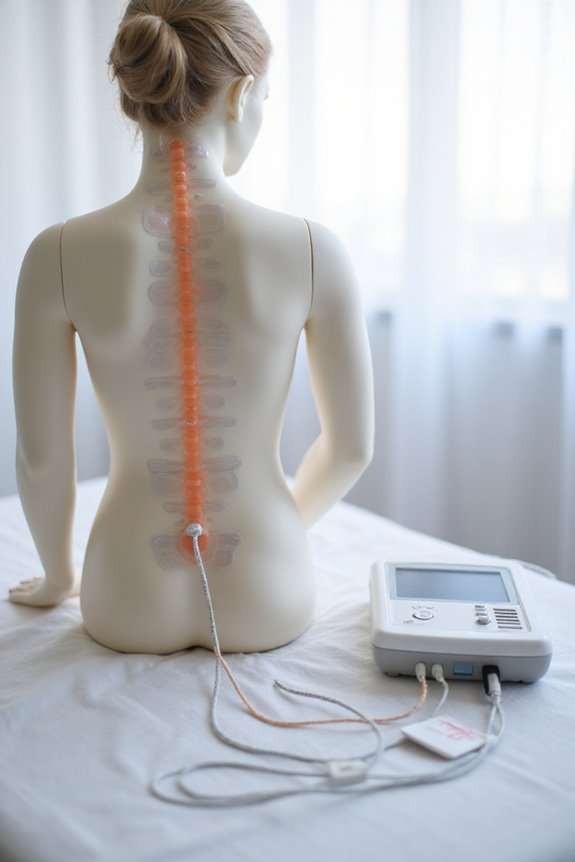
Proper electrode placement is essential for maximizing the effectiveness of a TENS unit. Effective electrode positioning not only enhances pain relief but also minimizes discomfort during use.
Key Techniques for Safe Electrode Placement:
- Skin Preparation: Clean the skin with soap and water, making sure it is free from oils, lotions, or dirt. This improves adhesion and conductivity.
- Positioning: Place electrodes around the area of pain, avoiding bony prominences. A common configuration is to position them at least one inch apart, forming a rectangular or square shape.
- Testing: Once applied, check the connection before initiating the TENS unit. Adjust if needed to guarantee peak effectiveness.
Monitoring Skin Safety and Irritation
Monitoring skin safety and irritation is essential for anyone using a TENS unit. Skin monitoring should occur before and after each session to identify early signs of irritation, such as redness, rash, or itching.
Irritation Prevention:
- Limit sessions to 30-60 minutes, with breaks of at least 10 minutes between uses.
- Change electrode locations to reduce repeated stress on the same area.
- Use skin prep products to enhance adhesion and minimize irritation.
- Keep the skin clean and moisturized, ensuring the area remains dry to prevent slippage.
When to Discontinue Use:
- Cease use immediately for persistent redness, rash, or discomfort.
- Consult a healthcare provider if any severe symptoms occur, such as blisters or allergic reactions.
Adjusting Frequency Based on Individual Needs
Adjusting the frequency of TENS unit use is essential for optimizing pain management based on individual needs.
- Session Length: Typical sessions last 30–60 minutes, with acute conditions often requiring 1–3 sessions daily. Chronic pain generally benefits from longer sessions, typically once a day or every other day.
- Personalized Adjustments: It is vital to assess pain levels before and after each session. Frequency may increase during flare-ups, while regular reassessment can guide ongoing frequency.
- Patient Factors: Individual medical history, pain threshold, and skin sensitivity influence the appropriate frequency for TENS use.
Taking breaks between sessions is also recommended to prevent skin issues and reduce tolerance buildup, ensuring effective pain management tailored to each individual’s unique needs.
Integrating TENS Into Daily Activities
Integrating a TENS unit into daily activities is a practical approach to managing pain effectively. Users can benefit from the portability of TENS units, allowing for use during light exercise or while seated.
TENS Integration Tips:
- Limit sessions to 30-60 minutes, repeating throughout the day as needed.
- Take breaks of at least 10 minutes between sessions to avoid skin irritation.
- Avoid use during bathing, sleeping, or driving to guarantee safety.
Daily Routine Strategies:
- Incorporate TENS therapy into regular tasks without disruption.
- Maintain a log to track session effectiveness and adjust treatment plans.
- Confirm the unit is turned off when not in use to conserve battery life.
These strategies can promote a seamless integration of TENS therapy into daily life.
Long-Term Benefits of Regular TENS Usage
Long-term usage of a TENS unit can yield significant benefits for individuals managing chronic pain conditions. Key advantages include:
- Long-term Pain Relief: Users often experience pain relief during and after sessions, with effects lasting up to 24 hours.
- Reduced Medication Use: Regular TENS application can lead to a notable decrease in the reliance on pain medications, promoting safer pain management.
- Endorphin Stimulation: The device stimulates endorphin production, enhancing natural pain relief.
Additionally, consistent TENS usage contributes to cost savings. By minimizing the need for alternative treatments and medications, individuals can efficiently manage their conditions while reducing overall healthcare expenses. This thorough approach makes TENS a valuable tool for chronic pain sufferers seeking sustainable relief.
Frequently Asked Questions
Can I Use a TENS Unit While Exercising?
Using a TENS unit while exercising can enhance pain relief and function. However, precautions like secure electrode placement and monitoring for irritation are essential to guarantee safety and effectiveness during physical activity.
Are There Any Side Effects From Using a TENS Unit?
Using a TENS unit can bring unexpected discomfort, such as skin irritation or muscle fatigue. Users may also experience an unusual electrical sensation. Awareness and care can foster a safer, more enjoyable experience for all involved.
How Do I Know if the TENS Unit Is Working?
To assess TENS unit effectiveness, one should notice sensations like gentle tingling under electrodes, observe muscle twitching, and experience pain relief during and after treatment. Consistent results indicate proper functioning and beneficial impact on discomfort management.
Can I Use a TENS Unit on My Neck or Head?
Using a TENS unit on the neck or head offers potential benefits but requires precautions. Proper electrode placement and consultation with a healthcare provider guarantee safety, facilitating effective pain management while minimizing risks associated with sensitive areas.
Is It Safe to Use a TENS Unit During Pregnancy?
TENS unit safety during pregnancy involves careful consideration. While generally safe, it’s essential to avoid electrode placement on the abdomen and seek professional guidance to guarantee appropriate use and minimize risks associated with individual pregnancy factors.

